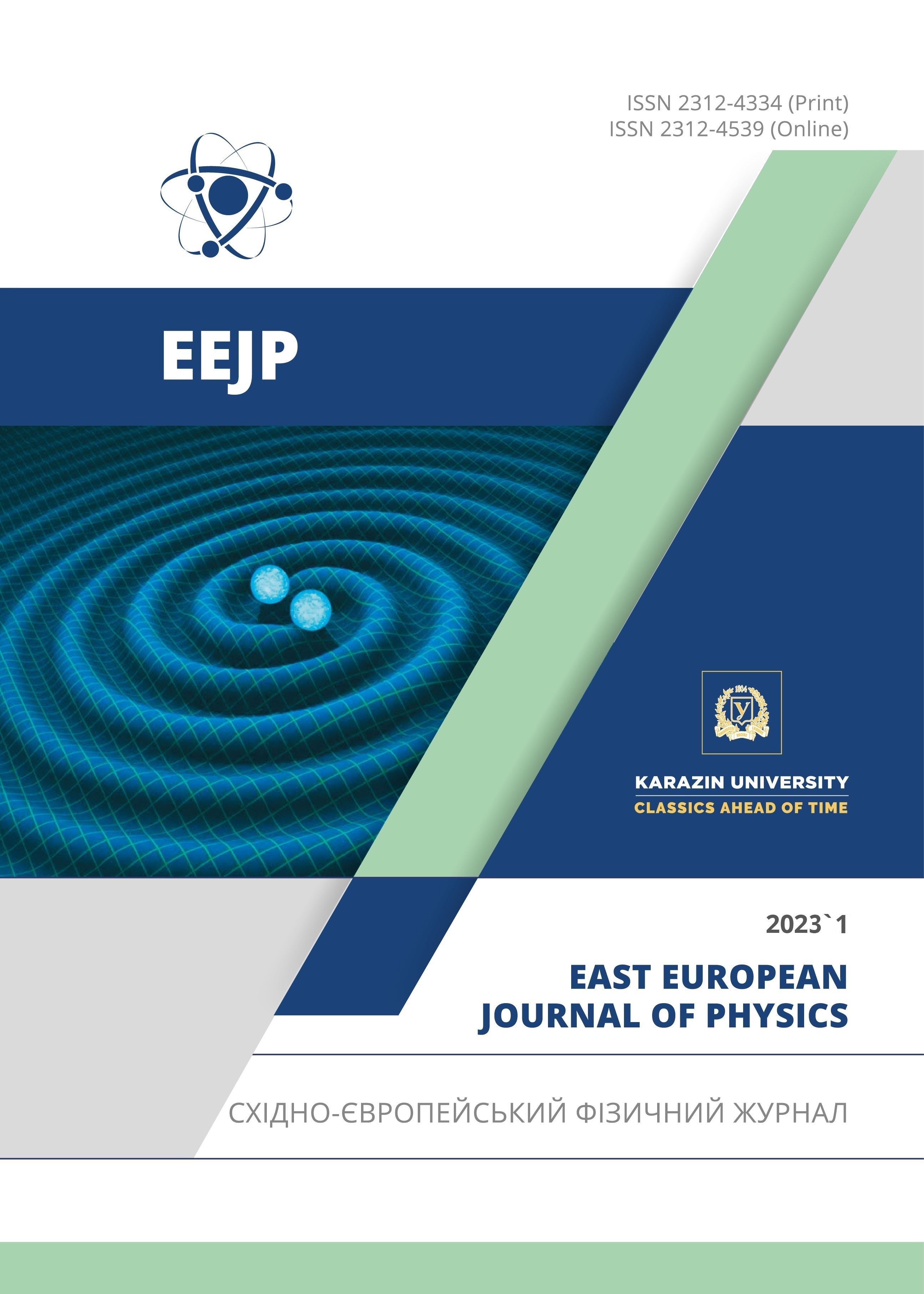Якісне теоретичне дослідження неорганічних сонячних елементів на основі RbGeI3 перовскіту без HTM, з використанням SCAPS-1D як шляху до 3,601% ефективності
Анотація
Наявність токсичного свинцю в перовскітних сонячних елементах перешкоджає їх комерційній життєздатності. У цій роботі було запропоновано та реалізовано мезоскопічні неорганічні безсвинцеві перовскітні сонячні батареї на основі RbGeI3 за допомогою інструменту моделювання SCAP. Було проаналізовано вплив матеріалу транспортування електронів (ETM) і товщини поглинача. Коли пристрій було вперше змодельовано, його ефективність перетворення потужності (PCE), коефіцієнт заповнення (FF), щільність струму (Jsc) і напруга холостого ходу (Voc) досягали значень 3,584%, 48,477% для коефіцієнта заповнення, 25,385 мА/см2 для Jsc і 0,291 В для Voc. Коли ETM і абсорбер мають ідеальну товщину 0,08 і 0,40, розвиток ефективності стає стабільним. Використовуючи вищезазначені параметри, оптимізований пристрій PSC дав такі значення: PCE = 3,601%, Jsc = 25,386 мА/см2, Voc = 0,291 В і FF = 48,637%. Покращення PCE порівняно з базовим пристроєм без оптимізації становить приблизно 1,01 рази. Отримані дані показують, що перовскітний сонячний елемент без HTM має значну здатність поглинати енергію фотонів і виробляти електрони. Він також показав, як створити екологічно чисту та економічно життєздатну технологію.
Завантаження
Посилання
E. Danladi, M. Kashif, A. Ichoja, and B.B. Ayiya, Transactions of Tianjin University, 28(5), (2022). https://doi.org/10.1007/s12209-022-00343-w
E. Danladi, M. Kashif, T.O Daniel, C.U. Achem, M. Alpha, and M. Gyan, East European Journal of Physics, 3, 19 (2022). https://doi.org/10.26565/2312-4334-2022-3-03
Z. Qu, F. Ma, Y. Zhao, X. Chu, S. Yu, and J. You, Chinese Physics Letters, 38, 107801 (2021). https://doi.org/10.1088/0256-307X/38/10/107801
A. Kojima, K. Teshima, Y. Shirai, and T. Miyasaka, Journal of American Chemical Society, 131, 6050 (2009). https://doi.org/10.1021/ja809598r
G. Pindolia, S.M. Shinde, P.K. Jha, Solar Energy, 236, 802 (2022). https://doi.org/10.1016/j.solener.2022.03.053
J. Wu, Y. Li, Y. Li, W. Xie, J. Shi, D. Li, S. Cheng, and Q. Meng, Journal of Materials Chemistry A, 9, 6382 (2021). https://doi.org/10.1039/D0TA12046D
J.J. Yoo, G. Seo, M.R. Chua, T.G. Park, Y. Lu, F. Rotermund, Y.K. Kim, et al., Nature, 590(7847), 587 (2021). https://doi.org/10.1038/s41586-021-03285-w
W. Ke, and M.G. Kanatzidis, Nature Communications, 10, 965 (2019). https://doi.org/10.1038/s41467-019-08918-3
N.K. Noel, S.D. Stranks, A. Abate, C. Wehrenfennig, S. Guarnera, A.A. Haghighirad, A. Sadhanala, G.E. Eperon, S.K. Pathak, M.B. Johnston, A. Petrozza, L.M. Herz, and H.J. Snaith, Energy & Environmental Science, 7, 3061 (2014). https://doi.org/10.1039/C4EE01076K
D. Saikia, J. Bera, A. Betal, and S. Sahu, Optical Materials, 123, 111839 (2022). https://doi.org/10.1016/j.optmat.2021.111839
T. Krishnamoorthy, H. Ding, C. Yan, W.L. Leong, T. Baikie, Z. Zhang, M. Sherburne, S. Li, M. Asta, N. Mathews, and S.G. Mhaisalkar, Journal of Materials Chemistry A, 3, 23829 (2015). https://doi.org/10.1039/C5TA05741H
D.K. Jayan, and V. Sebastian, Materials Today Communications, 28, 102650 (2021). https://doi.org/10.1016/j.mtcomm.2021.102650
M.G. Ju, M. Chen, Y. Zhou, J. Dai, L. Ma, N.P. Padture, and X.C. Zeng, Joule, 2, 1231 (2018). https://www.cell.com/joule/pdf/S2542-4351(18)30187-9.pdf
T. Leijtens, G.E. Eperon, N.K. Noel, S.N. Habisreutinger, A. Petrozza, and H.J. Snaith, Advanced Energy Materials, 5(20), 1500963 (2015). https://doi.org/10.1002/aenm.201500963
T.P.I. Saragi, T. Spehr, A. Siebert, T. Fuhrmann-Lieker, and J. Salbeck, Chemical Reviews, 107, 1011 (2007). https://doi.org/10.1021/cr0501341
J.M. Tour, R. Wu, and J.S. Schumm, Journal of the American Chemical Society, 112, 5662 (1990). https://doi.org/10.1021/ja00170a053
A.F. Akbulatov, L.A. Frolova, M.P. Griffin, I.R. Gearba, A. Dolocan, D.A. Vanden Bout, S. Tsarev, E.A. Katz, A.F. Shestakov, K.J. Stevenson, and P.A. Troshin, Advanced Energy Materials, 7, 1700476 (2017). https://doi.org/10.1002/aenm.201700476
Z. Hawash, L.K. Ono, S.R. Raga, M.V. Lee, and Y. Qi, Chemistry of Materials, 27, 562 (2015). https://doi.org/10.1021/cm504022q
A.K. Jena, Y. Numata, M. Ikegami, and T. Miyasaka, Journal of Materials Chemistry A, 6, 2219 (2018). https://doi.org/10.1039/C7TA07674F
K. Norrman, M.V. Madsen, S.A. Gevorgyan, and F.C. Krebs, Journal of the American Chemical Society, 132, 16883 (2010). https://doi.org/10.1021/ja106299g
L. Etgar, P. Gao Z. Xue, Q. Peng, A.K. Chandiran, B. Liu, M.K. Nazeeruddin, and M. Gratzel, Journal of the American Chemical Society, 134(42), 17396 (2012). https://doi.org/10.1021/ja307789s
M.O. Abdulmalik, E. Danladi, R.C. Obasi, P.M. Gyuk, F.U. Salifu, S. Magaji, A.C. Egbugha, and D. Thomas, East European Journal of Physics, 4, 125 (2022). https://periodicals.karazin.ua/eejp/article/view/20949
J. Barb´e, M.L. Tietze, M. Neophytou, B. Murali, E. Alarousu, A. el Labban, M. Abulikemu, W. Yue, O.F. Mohammed, I. McCulloch, A. Amassian, and S. del Gobbo, ACS Applied Materials Interfaces, 9, 11828 (2017). https://doi.org/10.1021/acsami.6b13675
S. Ahmed, F. Jannat, M.A.K. Khan, and M.A. Alim, Optik, 225, 165765 (2021). https://doi.org/10.1016/j.ijleo.2020.165765
Авторське право (c) 2023 Мері Т. Екву, Елі Данладі, Ніколас Н. Тасі, Ідоко С. Харуна, Осаретін Е. Окоро, Філібус М. Гюк, Олаїнка М. Джімох, Ріта К. Обасі

Цю роботу ліцензовано за Міжнародня ліцензія Creative Commons Attribution 4.0.
Автори, які публікуються у цьому журналі, погоджуються з наступними умовами:
- Автори залишають за собою право на авторство своєї роботи та передають журналу право першої публікації цієї роботи на умовах ліцензії Creative Commons Attribution License, котра дозволяє іншим особам вільно розповсюджувати опубліковану роботу з обов'язковим посиланням на авторів оригінальної роботи та першу публікацію роботи у цьому журналі.
- Автори мають право укладати самостійні додаткові угоди щодо неексклюзивного розповсюдження роботи у тому вигляді, в якому вона була опублікована цим журналом (наприклад, розміщувати роботу в електронному сховищі установи або публікувати у складі монографії), за умови збереження посилання на першу публікацію роботи у цьому журналі.
- Політика журналу дозволяє і заохочує розміщення авторами в мережі Інтернет (наприклад, у сховищах установ або на особистих веб-сайтах) рукопису роботи, як до подання цього рукопису до редакції, так і під час його редакційного опрацювання, оскільки це сприяє виникненню продуктивної наукової дискусії та позитивно позначається на оперативності та динаміці цитування опублікованої роботи (див. The Effect of Open Access).








